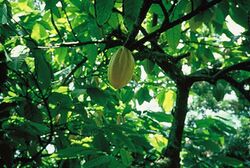Biology:Theobroma
| Theobroma | |
|---|---|

| |
| Theobroma cacao fruit | |
| Scientific classification | |
| Kingdom: | Plantae |
| Clade: | Tracheophytes |
| Clade: | Angiosperms |
| Clade: | Eudicots |
| Clade: | Rosids |
| Order: | Malvales |
| Family: | Malvaceae |
| Subfamily: | Byttnerioideae |
| Tribe: | Theobromateae |
| Genus: | Theobroma L.[1] |
| Type species | |
| Theobroma cacao | |
| Species | |
|
See text | |
| Synonyms | |
|
Cacao Mill. | |
Theobroma is a genus of flowering plants in the mallow family, Malvaceae, that is sometimes classified as a member of Sterculiaceae. It contains roughly 20 species of small understory trees native to the tropical forests of Central and South America.[2]
The seeds of the cacao tree (Theobroma cacao), the best known species of the genus, are used for making chocolate. Cupuaçu (Theobroma grandiflorum), mocambo (Theobroma bicolor) and capacui (Theobroma speciosum) are also of economic importance.
Taxonomy
The generic name is derived from the Greek words θεός theos meaning "god"[3] and βρῶμα broma meaning "food"[4] translating to "food of the gods".[5]
Species
Species of the genus according to Plants of the World Online (As of February 2023):[6]
| Image | Scientific name | Distribution |
|---|---|---|
| Theobroma angustifolium DC. | Costa Rica, Mexico, Nicaragua, Panamá | |
| Theobroma bernoullii Pittier | Panama. | |
 |
Theobroma bicolor Bonpl. – mocambo | Brazil North, Colombia, Peru, Venezuela |
 |
Theobroma cacao L. – cacao | Brazil, Colombia, Costa Rica, Ecuador, French Guiana, Guyana, Peru, Suriname, Venezuela |
| Theobroma canumanense Pires & Fróes ex Cuatrec. | Brazil | |
| Theobroma cirmolinae Cuatrec. | Colombia | |
| Theobroma gileri Cuatrec. | Colombia, Ecuador | |
 |
Theobroma glaucum H.Karst. | Brazil, Colombia, Ecuador, Peru |
 |
Theobroma grandiflorum (Willd. ex Spreng.) K.Schum. – cupuaçu | Bolivia, Brazil, Guyana, Venezuela |
| Theobroma hylaeum Cuatrec. | Colombia, Panamá | |
 |
Theobroma mammosum Cuatrec. & J.León | Costa Rica, Nicaragua |
| Theobroma microcarpum Mart. | Bolivia, Brazil, Colombia, Venezuela | |
| Theobroma nemorale Cuatrec. | Colombia | |
| Theobroma obovatum Klotzsch ex Bernoulli | Bolivia, Brazil, Colombia, Guyana, Peru, Venezuela | |
| Theobroma simiarum Donn.Sm. | Colombia, Costa Rica, Ecuador, Nicaragua, Panamá | |
| Theobroma sinuosum Pav. ex Huber | Brazil, Peru | |
 |
Theobroma speciosum Willd. ex Spreng. – cacaui | Bolivia, Brazil, Peru, Venezuela |
| Theobroma subincanum Mart. | Bolivia, Brazil, Colombia, Ecuador, French Guiana, Guyana, Suriname, Venezuela | |
| Theobroma sylvestre Aubl. ex Mart. | Brazil. | |
| Theobroma velutinum Benoist | Brazil, French Guiana, Suriname |
Formerly placed here
- Abroma augustum (L.) L.f. (as T. augustum L.)
- Guazuma ulmifolia Lam. (as T. guazuma L.)
- Herrania albiflora Goudot (as T. albiflorum (Goudot) De Wild.)
- Herrania mariae (Mart.) Decne. ex Goudot (as T. mariae (Mart.) K. Schum.)
- Herrania purpurea (Pittier) R. E. Schult. (as T. purpureum Pittier)[7]
Uses
Several species of Theobroma produce edible seeds, notably cacao, cupuaçu, and mocambo. Cacao is commercially valued as the source of cocoa and chocolate.[8]
Theobroma species are used as food plants by the larvae of some moths of the genus Endoclita, including E. chalybeatus, E. damor, E. hosei and E. sericeus. The larvae of another moth, Hypercompe muzina, feed exclusively on Theobroma cacao.
An active ingredient of cacao, theobromine, is named for the genus.
References
- ↑ 1.0 1.1 "Genus: Theobroma L.". Germplasm Resources Information Network. United States Department of Agriculture. 5 Jun 2003. http://www.ars-grin.gov/cgi-bin/npgs/html/genus.pl?12064.
- ↑ Genovese, Maria Inés; Barros, Helena Rudge de Moraes (2017), Mérillon, Jean-Michel; Ramawat, K.G., eds., "Theobroma cacao and Theobroma grandiflorum: Bioactive Compounds and Associated Health Benefits" (in en), Bioactive Molecules in Food (Cham: Springer International Publishing): pp. 1–22, doi:10.1007/978-3-319-54528-8_15-1, ISBN 978-3-319-54528-8, https://doi.org/10.1007/978-3-319-54528-8_15-1, retrieved 2023-03-21
- ↑ Liddell, Henry George; Scott, Robert (1940). "θεός". A Greek-English Lexicon. Perseus Digital Library. https://www.perseus.tufts.edu/hopper/text?doc=Perseus:text:1999.04.0057:entry=qeo/s.
- ↑ Liddell, Henry George; Scott, Robert (1940). "ἀ". A Greek-English Lexicon. Perseus Digital Library. https://www.perseus.tufts.edu/hopper/text?doc=Perseus:text:1999.04.0057:entry=brw=ma.
- ↑ "Theobroma - an overview | ScienceDirect Topics". https://www.sciencedirect.com/topics/agricultural-and-biological-sciences/theobroma.
- ↑ "Theobroma L. - Plants of the World Online". http://powo.science.kew.org/taxon/urn:lsid:ipni.org:names:30005713-2.
- ↑ "GRIN Species Records of Theobroma". Germplasm Resources Information Network. United States Department of Agriculture. http://www.ars-grin.gov/cgi-bin/npgs/html/splist.pl?12064.
- ↑ "Cupuassu, Theobroma grandiflorum". https://www.growables.org/information/TropicalFruit/Cupuassu.htm.
External links
Wikidata ☰ Q162078 entry
 |


